Introduction
Over the past two years, AI has been growing at an unprecedented rate. Generative AI is reaching new levels every day. AI tools like Chat-GPT, Gemini, Microsoft Copilot, Perplexity, Grok, and many others contribute to answering simple questions for individuals and helping scientists solve complex issues.
Day by day, AI-powered UX and intelligent systems are becoming an integral part of our lives. To interact with them on a broader spectrum, a new era of AI is emerging that is Agentic AI. To make Agentic AI work in a more structured and hassle-free manner with humans, the AX (Artificial Experience) is born.
What is AX? Exploring Agentic Experience in the Context of AI UX
Agentic Experience (AX) is a design paradigm for the age of AI agents. AX focuses on how an AI bot interacts with digital products, services, and ecosystems and provides the required results to humans or another system. These AI-driven systems are reshaping the future of UX design. Agents are not sophisticated chatbots; they are autonomous decision-makers acting on behalf of humans on a designated scale. The term Agentic Experience (AX) was first popularized by Samet Özkale in his LinkedIn article on how AX is redefining product design.
Agentic AI can interpret context, make decisions, and act independently on behalf of users or organizations. AX will determine how agents interpret, decide, and at what level they can act independently. In simple words, AI UX helps humans to navigate digital products, and AX helps AI agents.
With the rise of AI in product design UX, agents are becoming primary users of APIs, interfaces, and data. This requires standard, structured, and secured mechanisms for agents to:
- Understand capabilities (what actions are possible)
- Discover information
- Execute tasks efficiently
To provide the correct mechanisms for Agentic AI, AX plays an important role in shaping AI-enhanced user experiences. This evolution pushes UI UX design services to adapt for both human and AI-driven interactions.
Examples
Travel Booking
Instead of a person searching flights, comparing options, and booking tickets, an AI agent interacts directly with a travel API, interprets preferences, and books tickets. This showcases how AI-driven personalization in UX can remove friction from routine tasks.
E-commerce
Agents negotiate prices, compare specs, and auto-order supplies for individuals or businesses. It can also provide feedback and reviews on the product page on behalf of the user if the user raises concerns. Evaluating the response will help the seller while repurchasing the product. This shift is an example of how AI is changing UX in digital commerce.
Enterprise Systems
AX allows agents to generate reports, trigger workflows, or optimize operations with minimal human clicks, demonstrating the impact of AI on the user journey across business operations.
To explore how evolving AI systems are influencing the future of UX design, check out how collaboration between designers and developers is reshaping digital experiences.
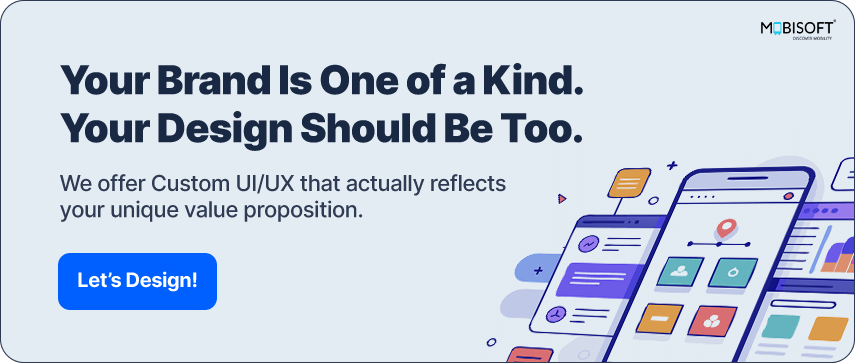
The Agentic Era of AI: Transforming the Future of UX Design
AI leaders across the board are pointing toward a clear trend: agents are becoming the next frontier in the evolution of large language models (LLMs).
In a recent interview with Wired, Google’s Demis Hassabis described this as the next big step change. Similarly, OpenAI’s Sam Altman has emphasized that helpful AI agents could become the technology’s "killer function".
And Anthropic’s Dario Amodei, in conversation with Ezra Klein, called this shift a "significant unlock", forecasting that we may be only months away from a widespread agentic future.
In an Agentic UX (AX), an AI agent primarily deals with three loads: cognitive, creative, and logistical.
- Cognitive: The built-in agent pulls analysis and makes decisions.
- Creative: The built-in agent takes on visualization and creates media.
- Logistical: The built-in agent makes tasks operational and builds workflows
This AI-first architecture is shaping the role of AI in digital experience design.
Why AX Matters for Creating Intelligent and Personalized User Experiences?
As I discussed earlier, it is a leap forward in the lifecycle of AI. Organizations will use AI more prominently, Agentic AI in their upcoming products and services, as they are providing more value to the customer experience. In today’s digital environment, we don’t just want a product with good UX. We need intelligent, adaptive systems that feel personalized and remain frictionless. Designing user experiences with AI makes this possible.
This can be easily achieved with Agentic AI, and with the help of AX, we can build intuitive AI user experiences tailored to end users. Leveraging AI development services helps companies accelerate the implementation of intelligent, agent-powered systems.
Examples of the Agentic future of UX are already here: Adobe’s Gen Studio, Intercom’s Copilot, and Dovetail’s Magic Experience are some of the products that are already establishing the AI and UX trends 2025. AX can bring the following capabilities to digital products and services:
Future Readiness
- AI agents not only interact with humans and machines they can also adapt, interact, and integrate with other AI bots. This enables seamless integration, a key requirement in AI and user interface design.
- This brings future readiness to the product, as integrating a new system with an existing one will be easy and less time-consuming.
Faster Task Completion
- The product built with AX will give instant results to the human supervisor, which will make his/her decision-making process faster & more efficient.
Scales Beyond Human Limitations
- Instead of manually doing the tasks one by one, agents can work on multiple tasks at the same time by using different bots allocated for the different tasks.
- Without any time constraints, an agent can run hundreds or thousands of tasks simultaneously, demonstrating the scale possible with AI-driven UX design.
Improves Reliability & Trust
- A good AX ensures consistent and predictable interactions for agents. It can reduce human errors and deliver AI-enhanced user experiences across platforms.
Creates Competitive Advantage
- Companies with strong AX design will always have more edge than any non-AX or average AX companies.
- It becomes a strategic differentiator, similar to how good UX became a market advantage in the 2010s.
A well-structured UX for customer experience helps build long-term user trust and loyalty, making AI-driven products more impactful.
How AX Differs from UX in AI-Enhanced Product Design?
The difference between AX (Artificial Experience) and UX (User Experience) is subtle at first, but it marks a fundamental shift in who/what the user is. While traditional UX design focuses on how humans react after interacting with a product, AX design shifts the perspective it's about how AI systems respond to human needs with minimal human interaction. This transition reflects the growing influence of AI in product design and UX.
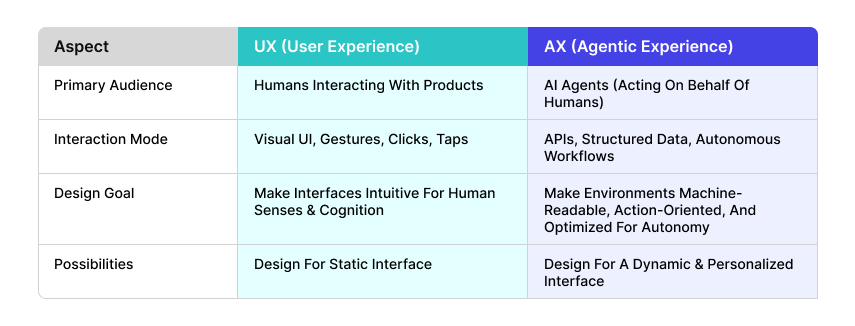
Investing in adaptive web UX design ensures systems can evolve with AI agent integrations.
Example: Travel Booking Platform
UX Perspective:
- Search bar for humans to type “Mumbai to Dubai”
- Filters for date, price, and airline
- Payment checkout flow for the user to complete manually
AX Perspective:
- API endpoint: POST /bookTrip with parameters {origin, destination, date, budget}
- AI agent chooses the best option, books a ticket instantly, and sends confirmation to the user, with no manual clicks
- The “experience” is designed for machine-to-system interaction, invisible to humans, demonstrating the impact of AI on the user journey
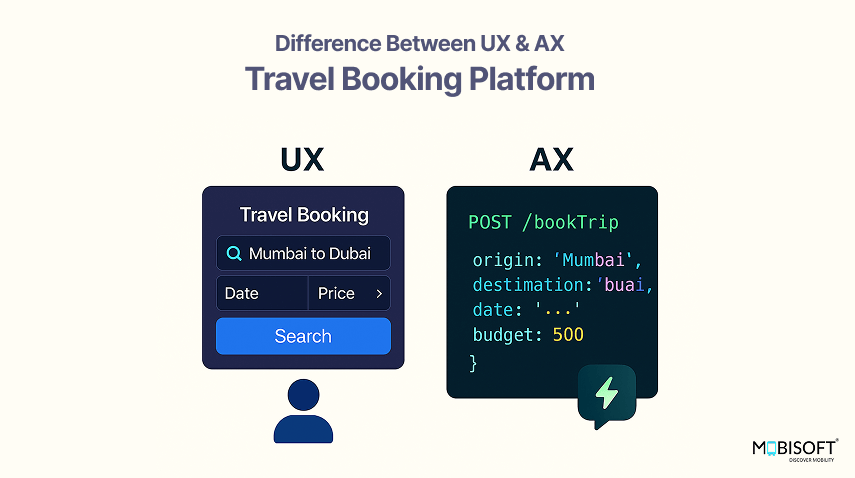
Is UX Dead or Evolving with Artificial Intelligence in UX?
Now you may have questions like:
- Is UX dead?
- Are there any similarities between AX & UX?
- If yes, will AX replace UX?
- If we are going forward, why is UX still required?
The simple answer is NO, UX is not dead, and AX is not here to replace UX. AX complements UX. Humans still interact with systems directly, which makes artificial intelligence in UX more meaningful. UX ensures better experiences through interfaces, while AX offers support indirectly through AI agents. Together, they create hybrid, intelligent experiences that feel invisible and effortless.
AX shifts the design mindset from “How will a person use this?” to “How will an agent understand, act, and collaborate here?” It’s essentially designing user experience with AI, or simply put, AI-enhanced user experience.
Shared Principles of Evaluating Effective AI UX and AX Design
Same Core Goal
- Both aim to help the “user” achieve a goal faster and efficiently.
- Simple and minimalistic approach
Measurement of success
- Task completion rate, Minimal friction, easy navigation, clear outcome
Principles of Good Design
- Clarity: For UX, navigation should be clear, same for AX APIs & capabilities should be clear
- Consistency: Predictable patterns help humans in UX and agents in AX.
- Error Handling: Both must identify issues. AX should deliver error messages readable by systems, reflecting best practices in AI UX.
- Task Status: Both must provide task status timely manner to the end user. The user should not feel stuck
- Feedback Loops: Both should confirm important decisions. In UX through confirmation popups & in AX via machine-readable status codes or events
Testing & Optimization
- UX focuses on usability with human testers.
- AX requires testing smooth integration with AI agents, often supported by the best AI tools for UX design.
Trust & Reliability
- UX builds trust through consistent design.
- AX builds reliability through system transparency, responsiveness, and uptime, central to AI for customer experience.
Key Principles Behind Building AI-Powered Agentic Experiences (AX)
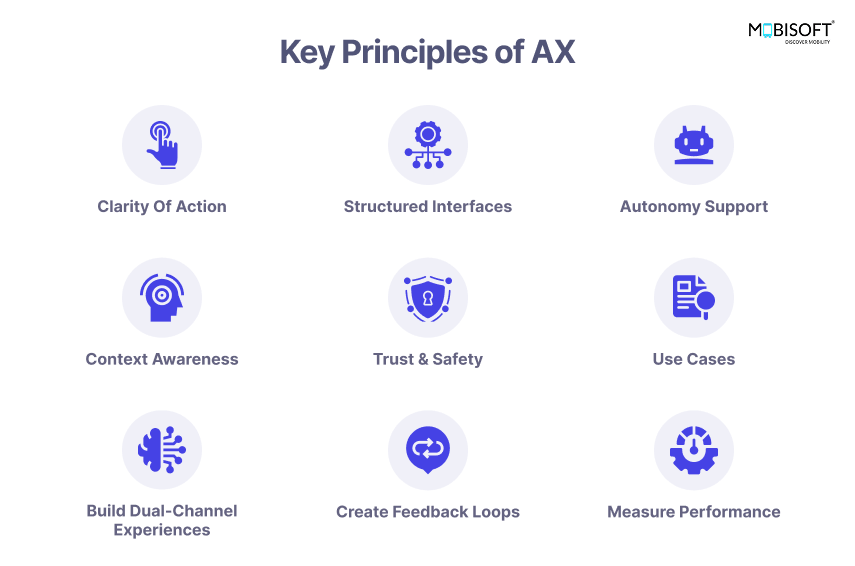
- Clarity of Action: Expose what the system can do, so agents can invoke capabilities reliably.
- Structured Interfaces: APIs, semantic markup, and machine-readable UIs designed for agents.
- Autonomy Support: Products should support goal-driven execution without constant human supervision.
- Context Awareness: Environments should adapt to the agent's understanding and context changes.
- Trust & Safety: Clear guidelines & parameters should be established for how agents act within the ecosystem.
- Use Cases: Start with High-Impact Use Cases to implement AI agents. Identify where autonomous AI can create immediate impact & bring measurable outcomes to the table.
- Build Dual-Channel Experiences: Design for both human and AI agents. Your product needs to be intuitive for both. If humans need to interfere in the task, there should be some provision.
- Create Feedback Loops: Implementation of an AI agent doesn’t mean humans need to check the evaluation parameter & result. Create Feedback Loops that can monitor agents’ credibility from time to time.
- Measure Performance: Just like UX, AX also needs to measure the performance of a system. AX needs continuous monitoring to track AI agent performance & tweak it accordingly for better results.
As AI UX in 2025 advances, these principles will be crucial for building trust in agentic systems.
Who Can Contribute to Designing AI UX and Agentic Experiences?
Right now, AX designer isn’t a single role, but multiple professionals can contribute to make a strong AX
- Product Designers / UX Designers: Apply UX principles but from the perspective of machine-to-system interaction
- Developers & Architects: Build compatible structures, agent-friendly APIs, and AI-ready workflows
- Product Managers: Define agent use cases, success metrics, trust policies, and feedback mechanisms
- AI Engineers: Integrate AI reasoning, natural language interfaces, and autonomy layers into autonomous UX systems
- Business Analysts: Map processes that agents can automate or optimize, contributing to UX for AI agents
Practical Applications of AX in Digital Products and AI-Driven UX
AX applies to any system, service, or product that can be integrated with autonomous AI agents.
- Software Platforms: SaaS apps, CRMs, ERPs with agent-friendly APIs
- Consumer Facing Apps: Banking, travel, e-commerce, healthcare & content management
- Enterprise Tools: Logistics, supply chain, and operations platforms aligned with an AI-first UX strategy.
- IoT & Hardware: Smart home systems or vehicles controllable by agents, practical examples of The Rise of AX.
Can UX Designers Move into AX Roles Without Coding Skills?
The quick answer is yes, but not fully. As I mentioned earlier, AX design is multiple people, a strong AX-driven Agent, but not knowing how to code is not a huge limitation. An AX designer still adds value by doing the following activities:
Define Agent Interaction Flows
Just like user journeys for humans, mapping how an agent should navigate and achieve a user goal is also an important a vital part of modern AI and UX workflows.
Design Agent-Facing Structures
Similar to accessibility design for screen readers, design machine-readable layouts, metadata, and structured information for autonomous UX systems.
Design a Hybrid User Interface
While designing a user interface for AI-enabled systems, designers need to think holistically & smartly. They need to design interfaces by considering both how humans will perceive data & how systems will show data.
Whenever required, interfaces should have the capability to switch control to a human or a machine without any hassle.
Collaborate on API behavior
Specifying requirements for clarity, discoverability, and predictable responses contributes to an effective AI-first UX strategy.
Work on trust & feedback mechanisms
Defining how agents “confirm” actions to humans helps reinforce trust within AI-powered user experiences.
For instance, mobile app UX design must now account for both user-centric interaction and AI-driven automation.
Final Thoughts: How AX Enhances the Future of UX and AI in Digital Experience
Agentic AI is the future, and AX will play a key role in making AI-enabled products, services & systems feel seamless. UX is not going anywhere; it's evolving to new horizons.
Following proven mobile app UX best practices will be key to bridging the gap between traditional user interfaces and AI-augmented agentic experiences.Right now, Agentic AI is still in its early stages, so the role of Agentic UX design might seem limited. But as Agentic AI matures, the true value and opportunities for UX for AI agents will start to shine, especially as we head into the landscape of AI UX in 2025.
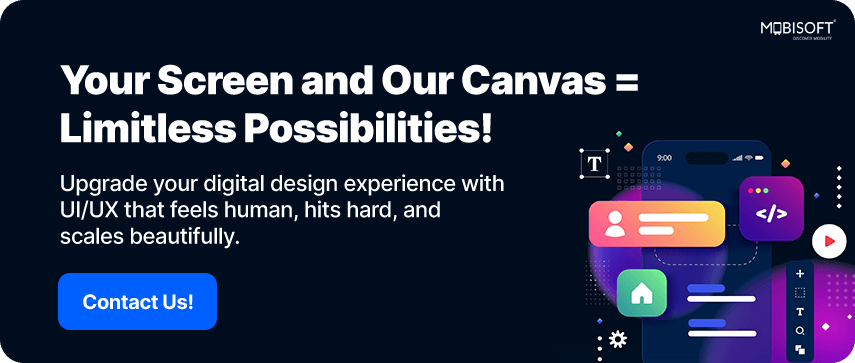

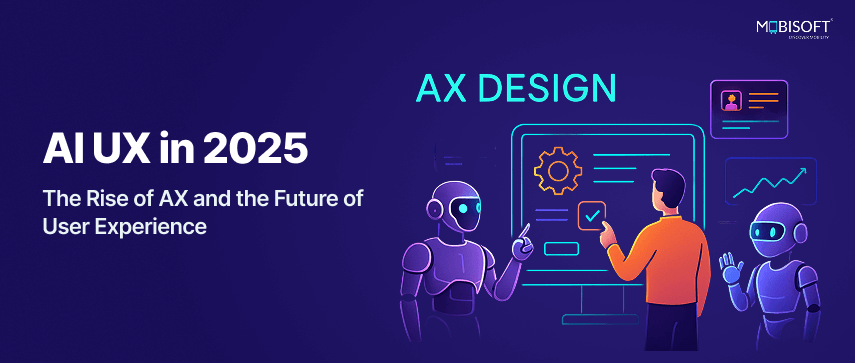


 August 7, 2025
August 7, 2025


